 |
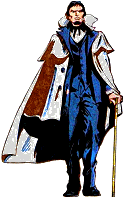 |
|
 SPOTLIGHT ON SPOTLIGHT ON
NIGHT FORCE #3
(OCTOBER 1982)
|
|
|
| |
|
| |
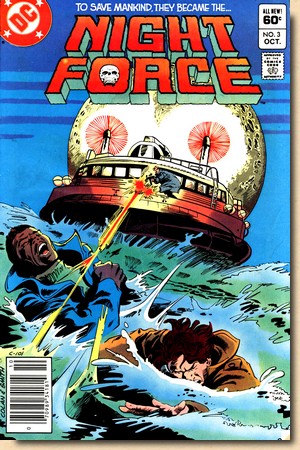 |
|
"The Summoning, Chapter
III: Journeys"
(23 pages)
Cover
pencils - Gene
Colan
Cover inks -
Bob
Smith
Story - Marv
Wolfman
Art - Gene Colan
Inks - Bob Smith
Colours - Michele Wolfman
Lettering -
John Costanza
Editor - Dick Giordano (Managing),
Marv Wolfman
on sale
22 June 1982
STORY OVERVIEW - When Vanessa Van
Helsing, great granddaughter of the famous
vampire hunter Abraham Van Helsing, is kidnapped
by shadowy forces from behind the Iron Curtain,
Baron Winter sends Jack Gold, a down on his luck
journalist, and Donovan Caine, an African
American parapsychologist - who both seem to hate
each other at first sight - first to London and
then into the depths of Siberia to rescue her.
|
|
| |
| |
THE SUPERNATURAL
COMIC BOOK TITLE OUT OF TIME
It was late 1980, and
"Gentleman" Gene Colan was leaving Marvel for
DC, feeling miserable after a protracted struggle he had
endured with Jim Shooter since the latter had become editor-in-chief in 1978 (Irving, 2010).
At DC, he met up again with Marv Wolfman, who himself had
left Marvel (also mostly due to Shooter) a few months
prior to Colan - as had other major Marvel alumni,
including Roy Thomas. Shooter was not only tightening the
reigns at Marvel but also pushing his own perception of
what a good comic book was, and the resulting fallout was
enormous (Howe, 2012).
"I left
because I had big problems with Shooter. Lots of
people just went right over to DC (...) Marv had
already gone over, and he wanted me to come along
(...) I thought maybe I could hack it with Shooter
around, but it just went from bad to worse, so I had
to leave. Well, I went over to DC and I did Night
Force."
(Gene
Colan, in CBR Staff 2000)
DC was determined
to make the most of Colan's shadowy and moody visuals,
and immediately assigned him to Detective Comics and Batman
(where Gene Colan was formally introduced to the DC readership
on the splashpage of Batman #340, cover dated October 1981 but
on sale as of 16 June 1981).
|
| |
|
Spotlighting
the exodus of A-list creative talent from Marvel
to its ranks, DC was also eager to promote the
reunion of Marv Wolfman and Gene Colan, who of
course had been nothing short of a "dream
team" back in the 1970s on Marvel's Tomb
of Dracula.

There
was, however, a slight problem with this - to all
intents and purposes the horror genre had
withered and died away by the time Colan and
Wolfman left Marvel.
Nevertheless, Wolfman
felt confident that a supernatural-themed comic
book could still be successful, and DC gave it
all the publicity it could while also resorting
to a somewhat unusual introduction of the Night
Force - as
a 16 page preview in New
Teen Titans #21 (a title with which Wolfman was
enjoying a highly successful run at the time,
thus giving the project an extra boost).
|
|
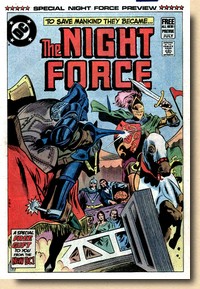
Preview in New
Teen Titans #21 (July 1982)
|
|
| |
|
Ultimately, DC blew its trumpet
on Night Force in a way which was highly
reminiscent of the Marvel hyperbole of the 1970s. |
| |
 |
|


It wouldn't
be the only thing that would remind those in the
know of Marvel when Night Force #1 went
on sale May 20th 1982, cover dated for August
1982. As a matter of fact, Marv Wolfman himself
brought up more parallel lines in a
first-issue-editorial.
After an overview of the
history of horror comics, Wolfman
dedicated no less than three entire
paragraphs to highlighting the
(undisputed) merits of Tomb of
Dracula before pointing out that
"not
only did Gene [Colan] and I come to
DC, but so did Dracula's virtually
full-time letterer, John Costanza
(...) Also, Dracula's colorist,
Michele Wolfman (yes, my wife!) has
returned to the dye-pot to add the
proper mood we seek."
Although Wolfman emphasized repeatedly
that "Night Force is something
different in comics", readers
could probably be forgiven for thus
expecting this
creative
team to somehow continue the legacy of Tomb
of Dracula
(Francoeur,
2013). The fact that
one of the main
characters introduced in this first issue
was Vanessa Van Helsing, great
granddaughter of Abraham Van Helsing
(which made her a sister of Rachel Van
Helsing from Tomb of Dracula)
didn't disperse any such expectations
either.
|
|
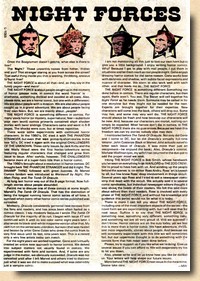 |
All in
all, it looked a lot like "flipping the
bat" (forgive the pun) to Jim Shooter at
Marvel - as indeed a lot of fans were quite
expecting to see, given that the discontent and
even hurt felt by Wolfman and Colan was no
secret.
|
|
| |
But the fact of the matter was
that Wolfman meant what he said - Night Force
was to be a totally different type of mystery
plus horror plus supernatural title.
"Suffice it
to say that THE NIGHT FORCE is something new,
something very different, something risky,
and something we are all very proud of. Will
we succeed? I don't know. Horror comics are
on the outs today, yet we feel this is more
than a horror comic. We have adventure,
thrills, and more importantly, stories about
people." (Wolfman, 1982)
|
|
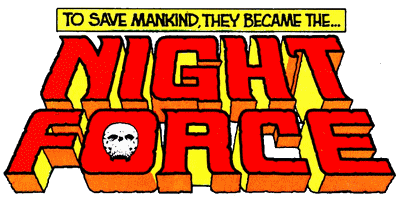 |
|
| |
| At the centre of the Night Force
was Baron Winters, a mysterious
sorcerer who lives in eerie Wintersgate Manor, located in
the Georgetown area of Washington DC. The building functions
as a gateway portal to different locations and time
periods, enabling the Baron to move to any other location
and/or time era - with the exception of actually just
stepping out onto the lawn around Wintersgate Manor in
the here and now, where he was somehow restricted to
dwelling inside the manor's walls. |
| |
| |
REVIEW & ANALYSIS
|
| |
| Night Force #3 starts out in Washington DC,
from where the mysterious Baron Winter sends a journalist
who has fallen on hard times (Jack Gold) and an African
American parapsychologist (Donovan Caine) to London, from
where their assignment - to find and free kidnapped
Vanessa Van Helsing, great granddaughter of the famous
vampire hunter Abraham Van Helsing - takes them
behind the Iron Curtain to Siberia. Obviously
still an early issue in the series, Night Force
#3 highlights both the strengths and weaknesses of the
underlying concept in an almost exemplary way. Everything
seems to be "as well as": the plot moves fast
but feels strangely disoriented, the characterization of
Gold and Caine and their clear disliking of each other
goes from interesting to tedious rather quickly, and the
mystery behind both the Baron and Vanessa Van Helsing is
both intriguing and lifeless at the same time.
In spite of the creative talent
involved and Wolfman's enthusiasm, Night Force didn't
work as intended. There are some die-hard fans who will
disagree, but the ultimate proof of the pudding for comic
books is early cancellation, and in the case of Night
Force this came after 14 issues - even though Marv
Wolfman saw the reason for this in a substantially wrong
perception of the sales figures.
|
| |
"DC wanted to
have Night Force be one of the first
direct-sales books, where I believed it
should be newsstand only. I felt the comic
shops appealed primarily to the superhero
fans while Night Force would appeal more to
the casual mainstream reader, who might not
have bought comics otherwise. We got the
comic-book shops' sales early and it was
cancelled based on those, but when the
newsstand sales finally dribbled in we
actually sold pretty well." (Marv
Wolfman, in Kingman 2008)
So did DC let the axe come
down somewhat prematurely? The real question is:
was DC looking to put out a series that wouldn't
sell too well but be critically hailed as a
groundbreaking milestone of innovation in comic
books? And if so, would they be happy to put the
"masters of the macabre", just recently
lured away from rival Marvel, to work on such a
title? It is hard to see any of that holding much
appeal for DC, who clearly wanted Wolfman and
Colan to come up with a series that would be as
successful as the one they had put out for Marvel
with Tomb of Dracula.
But that
wasn't going to happen. The high tide of the
horror genre in comic books had come and, most
importantly and unfortunately for Night Force,
gone. The decision makers at DC had probably
hoped for some sort of revival, but a series that
had a number of problems almost built into its
DNA was not going to trigger that - something
that Marv Wolfman himself was very much aware of
and frank about.
|
|
| |
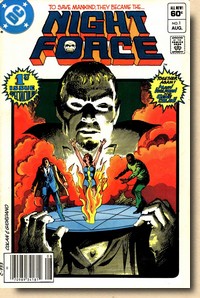
Night
Force (vol 1) #1
(July 1982)
|
|
One central problem that plagued
the series from its outset was the lack
of a stable and regular cast of characters
- even though the revolving door concept as
explained by Wolfman made sense and sounded
perfectly good and interesting.
"There are
regular characters, but then again, there
aren't. You see, the Baron will call together
his Night Force as he needs them. Someone may
be called in for one storyline but they might
not be needed for the next."
(Wolfman, 1982)
Unfortunately, it didn't
work the way it was intended to, which was
primarily due to the fact that the pivotal
persona - Baron Winters - was often so vague and
even elusive that he ultimately provided a very
weak link to the various other characters and
storylines.
"Baron
Winters is obsessed with the balance of good
and evil. He doesn’t really care which
side comes out victorious in individual
battles, as it doesn’t matter, as long
as things are balanced." (Marv
Wolfman, in Salvatore 2018)
"I was
planning to do some kind of origin [of Baron
Winters] at some point but I always felt that
you'd never know if anything Winters said was
true or not." (Marv Wolfman, in
Kingman 2008)
|
|
| |
| This reason for his ambiguity, however, was never
explicitly revealed nor explained at the time of the
original Night Force run, and what started out
as an initially intriguing plot device soon turned into a
somewhat annoying suspicion that all those dangling
questions would most likely never be answered. Asked years later in an interview if
Wolfman was planning on revealing the reason for Winters'
inability to actually leave Wintersgate Manor, his answer
still kept the question marks floating.
"I had my reasons;
they were part of the bible I wrote. But no, I
won’t share them until I’m given the
opportunity to do another series, if that ever
happens." (Marv Wolfman, in NN 2008)
Wolfman did actually get the
opportunity, in 2012, when DC once again brought back
Night Force (after a previous - and failed - revival
in 1996/97). However, he once more chose to keep the key
to that mystery to himself.
The same lack of definition also
extended to the characters making up the Night Force team
of the first story.
|
| |
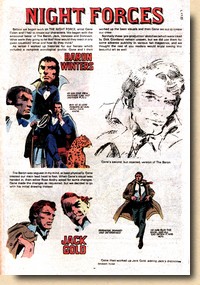
Page
24, Night Force #3
|
|
This was a shame and also
not really understandable, since a double
page feature at the end of Night
Force #3 spelled out and illustrated
the enormous amount of preparation and
design studies by Wolfman and Colan that
had gone into the creation of characters
and the setting of the title. But somehow, most of
those intricate and deep conceptual ideas
simply did not translate into
characterization or a plot that pulled
readers in. Night Force #3 is a
good example; the initial pages are
intriguing and create an interest in the
story to unfold, but once the actual
events get into gear and the characters
start to move on within the storyline, it
all begins to feel strangely detached.
Given the creative
team involved, it seems safe to assume
that a fairly large number of readers
really wanted to like this comic book,
but for some reason it just wasn't easy
to do so, and the lack of a central cast
of interesting and engaging characters
certainly didn't help.
|
|
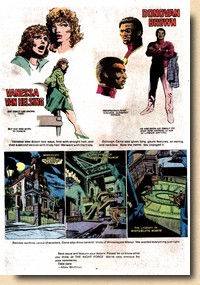
Page
25, Night Force #3
|
|
|
| |
| Wolfman was acutely aware of the
problem, and brought it up in the letters column of Night
Force #2 when he was telling readers (again) about
the potential tripwires the title faced [bold highlight
added for this write-up]. |
| |
 |
|
"Our
second strike against us (as the experts
tell us) is our lack of
a regular cast. They
say readers want characters to be in
every issue. They want their heroes clear
cut. Well, THE NIGHT FORCE has neither
(...) That might prove to be a problem,
but we think it's one of our greatest
strengths (...) Our heroes are not always
heroes in the strictest sense of the
word, therefore two more strikes against
us (or so the experts say)."
(Marv Wolfman, letters
column, Night Force #2) |
|
|
| |
| Experts aren't always right, but
on this occasion, and unlike what Wolfman was
suggesting/hoping, they may have not been entirely off
the mark. |
| |
| Another problem was an extremely extended
first story arc. Including the preview in New
Teen Titans #21, it took eight and a half issues to tell,
which even by today's standards (where writers plan their
stories in five or six issue segments in order to fit the
trade paperback format) is a highly strung out storyline.
But in 1982, an introductory storyline spread out over 9
months of real time was, quite simply, way out there. |
| |
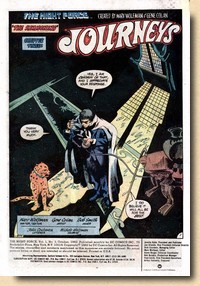
Splashpage,
Night Force #3
|
|
The problem with this
approach was that it required readers to
really be (and remain) invested in the
characters and the tale that Wolfman and
Colan were presenting to them. If they
weren’t drawn in after the first few
issues, they would drop off, most likely
never to return. At
the same time, such a long initial story
arc meant that if Night Force #3
was the first issue of the series you
picked up, you might have a problem
getting into things as there was no real
recap of previous events worth
mentioning.
Given the type of
plot Wolfman was weaving (one that was
aimed at a more mature readership), this
was actually understandable, but the
extended length of the initial arc
amplified the risk of not enabling new
readers to come on board late and still
understand what was going on. It also
meant that new readers couldn't be banked
on to make up for those who had left
after a few issues.
|
|
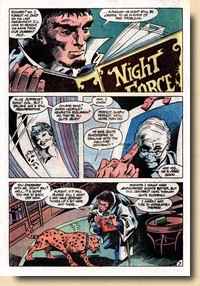
Page
3, Night Force #3
|
|
|
| |
| Marv Wolfman highlighted the
problems associated with this concept mself in the
letters column of Night Force #2 [again, bold
highlights added for this write-up]. |
| |
 |
|
"Our
stories are multi-part
stories. They require
you to be with us every issue.
And since we're not recapping everything
on page two (as most comics do) we're
not making it easy for new readers
(although we believe new readers can pick
up the storyline at any rate)."
(Marv Wolfman, letters
column, Night Force #2) |
|
|
| |
Of course Wolfman had good creative reasons for such
an approach.
"In most comics
change comes slowly if at all. Not so here. One of
the reasons is the approach we're taking. Each story,
as we stated, takes several issues. They will
progress like a novel; characters will change during
the course of the storyline (...) This is radically
different from the way comics are usually handled,
and this is the one thing we're proudest of in our
new creation." (Marv Wolfman, letters
column, Night Force #2)
|
| |
| Unfortunately for Wolfman and DC,
it was another innovative gamble that simply didn't pay
off. |
| |
Another problem was rooted in the fact that
Tomb of Dracula
cast too long a shadow over the series.
It must have been clear to everyone right from the
beginning that a horror/supernatural title by Marv
Wolfman and Gene Colan would instantly and continuously
be compared to Tomb of Dracula. There was no way
of ignoring this, and it would always be something of a
tightrope walk (not the least since DC's public relations
people were clearly pushing the
"Wolfman-Colan-Horror" clout).
"I was looking for
another book to do and felt I’d like to create
my own horror title and push the boundaries a bit
more than I had with Tomb of Dracula. I really wanted
to try something different (...) The idea was to
write for the older audience, with darker and more
realistic stories than had been done at that
point." (Marv Wolfman, in Kingman 2008)
The catch 22 here was, of course,
that the more Tomb of Dracula got mentioned, the
more difficult it became to avoid having everybody
compare the two titles.
|
| |
 |
|
"Permit
me to discuss (...) at some length Marvel's
The Tomb of Dracula
(...) Modestly, Dracula consistently
garnered rave reviews (...) and has since
been often hailed as a
comics classic. I say
modestly because I wrote
The Tomb of Dracula for
the majority of its run (...) but even
that was rivaled and beaten by artist Gene
Colan who drew the comic from its very
first issue until its last,
nine years later (...) Dracula was not
cancelled until after I left Marvel and
others tried to discover just what it was
we did to make succeed what was
ostensibly only a vampire comic."
(Marv Wolfman, Night
Forces, Night Force #1) |
|
|
| |
| Wolfman was right about
everything he stated there (except that Tomb of
Dracula was actually cancelled while he was indeed
still at Marvel, providing what was most likely the
ultimate fallout with editor in chief Jim Shooter and the
straw that broke the camel's back, leading to his
departure for DC), yet clearly misjudged the effect of
these repeat references to TOD (including the previously
quoted reference to its original creative team all being
reunited for Night Force). Hints were seen and
taken and false expectations raised as a consequence,
even if none of it was ever intended that way. |
| |
| But the single biggest mistake in
this context must be Wolfman's decision to introduce a
character named Vanessa Van Helsing. |
| |
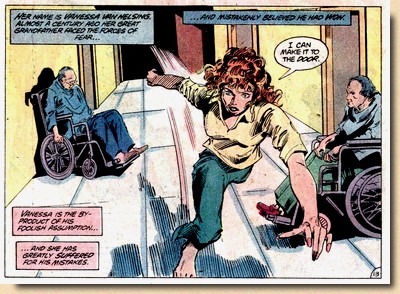
Night
Force (vol 1) #1 (July 1982)
Page 13, introduction of Vanessa Van Helsing's
name
|
|
Seen as "a nod to their
previous Tomb of Dracula work" (Dallas,
2013), having a persona who was the sister of one
of the main characters of Tomb of Dracula
(Rachel Van Helsing) almost invalidated any claim
that this was not, in no shape or form, intended
to be a continuation. At the least, there was now
a link. Wolfman himself
encouraged such a view. Right off the bat (again,
pardon the pun), in Night Force #1, he
introduces Vanessa as a patient at a mental
institution in Georgetown.
A few pages later, it is
not only revealed that her full name is Vanessa
Van Helsing, but this is combined, in the very
same panel, with Wolfman's exposition that "almost
a century ago her great grandfather faced the
forces of fear... and mistakenly believed he had
won."
Anybody who had read the
final issue of Tomb of Dracula could be
forgiven for thinking that this was as direct a
reference to the very last panel of that comic
book that you could possibly get.
|
|
| |
| Things got even more complicated (some might say
convoluted) when Night Force #13 revealed that
the Baron was Vanessa's father. The statement as such is
made in a context which makes readers assume it's another
one of those occasion where the Baron is strategically
not telling the truth in order to confuse people, but at
least for a moment Wolfman throws out the thought to
readers that Baron Winters could be - Abraham Van
Helsing's grandson. An impossibility in the context of
Bram Stoker's novel, this again leaves only Marvel's Tomb
of Dracula (where, of course, Abraham Van Helsing
does indeed have a great granddaughter) as reference
point. The crux of all of this was
that Night Force had indeed nothing to do with Tomb
of Dracula, so any such expectations would lead to
disappointment. But then the shadow of the tales of the
vampire count loomed big and long over Gene Colan too,
who couldn't quite detach himself from his previous work
on Tomb of Dracula either.
|
| |
 The final panel of page
18 (above) and the first two panels of page 19
(below) from Night Force #3 show Jack Gold and
Donovan Caine arriving in London and hailing a
cab.
A comparison
with the first two panels of page 11 from Tomb
of Dracula #24 (right) reveals some striking
resemblances.
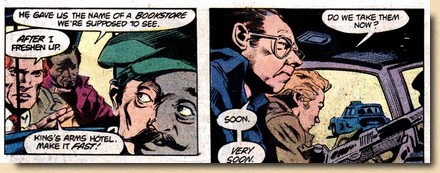
|
|
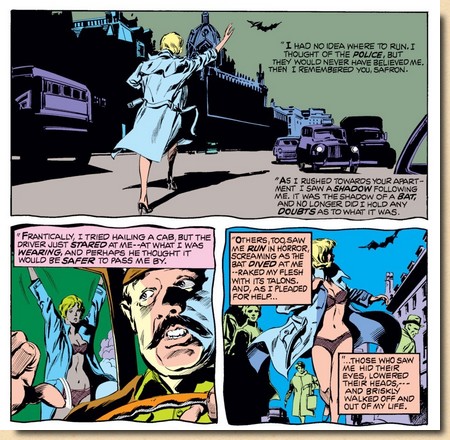 |
|
| |
Gene Colan's artwork was of the usual high quality,
but in comparison to Tomb of Dracula, the
"DC house rules" were quite evident and
prevented the finished product from having the famous
somber and shadowy feel which had made Marvel's title so
effective and loved by fans.
"DC
was a tough outfit. They wanted an in-house look for
all of the artwork, and they wanted the artists to
draw somewhat the same." (Irving, 2010)
As
a result, DC's "clean" final artwork style
stifled Colan's complex pencils much more than any inker
at Marvel ever had.
"My
style just doesn't lend itself well to inking. I
always had a lot of in-between shading that the inker
didn't know how to interpret or just didn't want to
bother. It was very time consuming. I've seen it
described as cinematic, which is a description I
really like because I do try to make it look like a
movie." (Gene Colan, in CBR Staff 2000)
|
| |
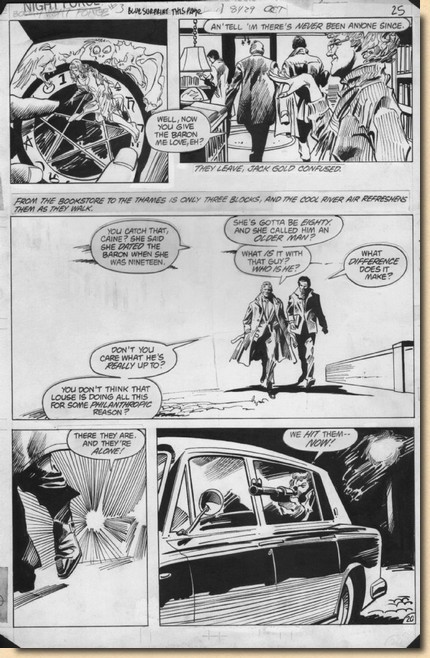
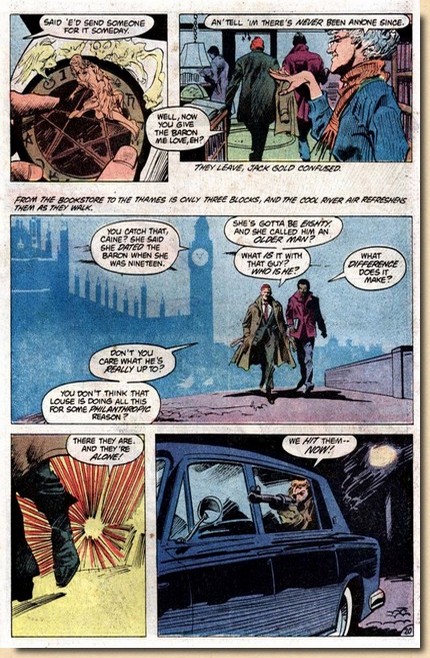
Original
artwork by Gene Colan for page 20 of Night Force
#3 (scanned from the original), and as it
appeared in print;
Note that the pasted word balloon of the first
panel had come loose and was subsequently lost
over time
|
|
| |
| |
FADING INTO THE NIGHT
|
| |
| Night Force was launched with great hopes in
early 1982, but ended in all-around disappointment by
mid-1983. The only solace for all the creative talent
involved was that it hardly came as much of a surprise. As Marv Wolfman had pointed out so
often and repeatedly, Night Force was different.
The dissimilarity to most other comic book titles
included how openly its author used editorial space to
convey the struggles and problems he assumed Night
Force may well face.
|

Night
Force #1
(July 1982)

Night
Force #3
(October 1982)
|
|
"In a
market that seems not only to want
super-heroes, but seemingly wants only
super-heroes, a
mystery/supernatural/horror comic
such as THE NIGHT FORCE is obviously
a risky gamble." (Marv
Wolfman, letters
column, Night Force #2)
This even went as
far as appealing to readers to really
throw in their weight in order to support
the title.
"Whether
we survive the economic crunch and
the current glut of competing comics
or not we know we'll have tried our
hardest to provide something good,
something new, and something we
obviously care about a lot. But we
need you if we are to survive. You
see, THE NIGHT FORCE has so much
going against it that we can only
hope you people will like us, follow
us, and tell your friends about
it." (Marv Wolfman, letters
column, Night Force #2)
Of course Stan Lee
had done pretty much the same thing for
the past two decades, but his appeals
always sounded slick and positive (of
course you would want to share the good
news with your friends). But Marv Wolfman
was far too level-headed to resort to any
such hyperbole. However, his no-frills
approach with readers came with the
downside that his statements and messages
could (and indeed did), at times, take on
a rather sombre or even downright
negative tone.
"That's
a lot of problems, so why did DC go
out on the proverbial line and
publish such a risky comic? Why turn
out a non-super-hero comic? Why
simply not follow the lead instead of
creating a new approach? Why? Because
we think THE NIGHT FORCE is a good
comic. It's that simple. We think
comic book readers will buy something
that is good even if our protagonists
don't wear capes. We think solid
story-telling, dynamic artwork, and
the best product we can turn out will
sell. At least we hope so."
(Marv Wolfman, letters
column, Night Force #2)
|
|
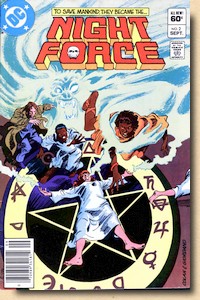
Night
Force #2
(September 1982)
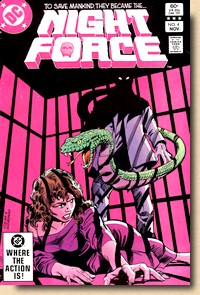
Night
Force #4
(November 1982)
|
|
|
| |
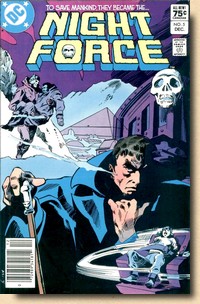
Night Force #5
(December 1982)
|
|
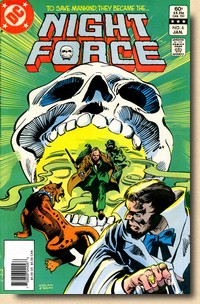
Night Force #6
(January 1983)
|
|
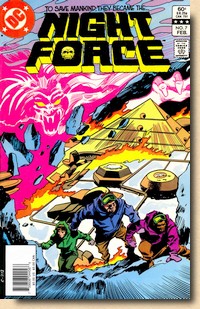
Night Force #7
(February 1983)
|
|
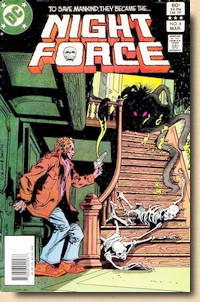
Night Force #8
(March 1983)
|
|
|
|
| |
| |
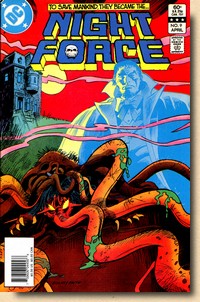
Night
Force #9
(April 1983)
|
|
But regardless of content
quality, the sales figures of Night
Force did not match the hopes of
Wolfman and the expectations of DC. After
seven issues, the length of storylines
was changed to more conventional formats.
"Our
first storyline is over and our
second begins. After this 2½-parter,
which ends in issue #10, we'll
continue doing several shorter yarns
- one and two parters at most -
before plunging ahead with another
multi-parter. Why? Well, despite the
incredible mail reaction to THE NIGHT
FORCE, sales are a bit sluggish, and
we think several smaller stories will
help allow new readers to see THE
NIGHT FORCE in action before making
the demands of another six to eight
part novel." (Marv Wolfman,
letters
column, Night Force #8)
Clearly the
extended initial storyline had cost Night
Force quite a few potential and
actual readers, and now Wolfman and DC
could only hope that the damage could be
contained.
|
|
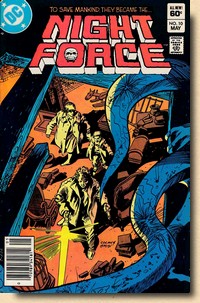
Night
Force #10
(May 1983)
|
|
|
| |
But sales continued to indicate that the risks
Wolfman had taken (and pointed out repeatedly in issues
#1 and #2) had now truly come to not just haunt, but in
effect sink the Night Force.
"With our next issue,
which concludes the current storyline, THE NIGHT
FORCE comes to a sad ending. We just couldn't bring
together enough readers to keep NF going." (Marv
Wolfman, letters
column, Night Force #13)
Wolfman was at least able to
sweeten the bitter news a bit by pointing out that
"NIGHT FORCE isn't
dead... starting next year we will be releasing THE
NIGHT FORCE as a four-part mini-series, one each
year." (Marv Wolfman, letters
column, Night Force #13)
That mini-series would, however,
never see the light of day, and so Night Force
#14 (September 1983) truly ushered in the end.
"This is it, the
final issue of NIGHT FORCE. We leave this title with
great regret and sorrow (...) There may be other news
concerning THE NIGHT FORCE coming from DC within the
next months, so please keep alert. If things pan out,
the best is yet to come." (Marv Wolfman, letters
column, Night Force #13)
|
| |
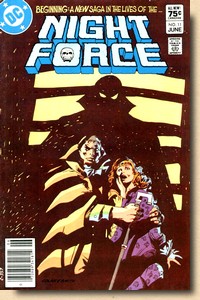
Night Force #11
(June 1983)
|
|
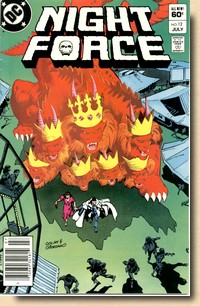
Night Force #12
(July 1983)
|
|
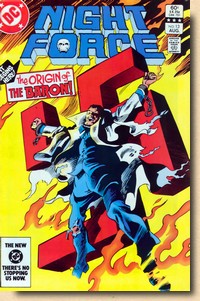
Night Force #13
(August1983)
|
|
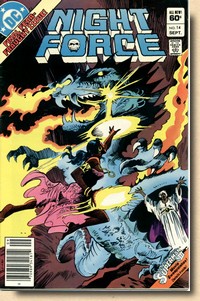
Night Force #14
(September 1983)
|
|
|
|
| |
| In the end, however, nothing
panned out, and Wolfman was left feeling very
disappointed by the cancellation of Night Force
for years - not the least because two attempts at giving Night
Force a fresh start, in 1996 and 2012, fared even
worse than the 1982/83 run. |
| |
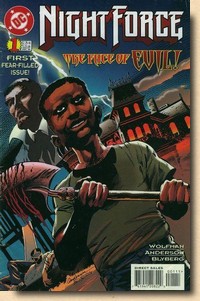
Night
Force (vol 2) #1
(December 1996)
|
|
The failure of the 1996
and 2012 runs would also seem to indicate
that it wasn't just a question of the
concept having potentially been ahead of
its time back in 1982. Wolfman himself
repeatedly stressed the fact that
"it’s
one of the most adult and complex
ideas I’d come up with and
I’ve enjoyed being the one
writer who has guided its
development. (...) If there was any
one project I’ve been most
protective of it’s probably
Night Force." (Marv
Wolfman, in West 2017)
Complexity itself
doesn't, however, automatically explain
the failure of Night Force
(since it certainly was an important
element in the success of Tomb of
Dracula). The letters pages (which
Wolfman insisted on calling letters
columns) were always full of (often
even unconditional) praise, but then that
would almost make it seem as though the
vast majority of individuals who didn't
like Night Force stopped buying
the title long before they could even be
bothered to write in about their
misgivings.
|
|
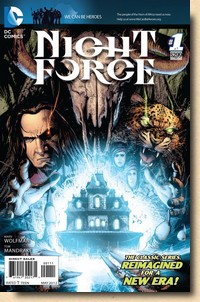
Night
Force (vol 3) #1
(March 2012)
|
|
|
| |
| Ultimately, the creative team of Tomb
of Dracula, all re-assembled for Night Force,
found that the times had changed, and they simply
couldn't repeat the magic they had previously produced. |
| |
| |
|
| |
| BIBLIOGRAPHY
BARK Jasper
(2018) "Injured Eyeballs: What the Fuck
was Night Force?",
This is Horror, published online 27 June 2018
CBR Staff
(2000) "Gene Colan Interview", CBR, published
online 6 August 2000
DALLAS
Keith (2013) American Comic Book Chronicles,
The 1980's (1980-1989), TwoMorrows Publishing
FRANCOEUR
Justin (2013) "Review of Night Force v1 ongoing series
(1982)", DC in the 80s,
published online August 2013
HOWE
Sean (2012) Marvel Comics: The Untold Story,
Harper Collins
IRVING
Christopher (2010) "Gene Colan: On Vampires, Shadows, and the
Industry", www.nycgraphicnovelists.com
KINGMAN Jim
(2008) "Forces of the Night, what Horrors they
faced: Marv Wolfman and Gene Colan's Night Force",
in Back Issue! #27 (April 2008)
NN (2008)
"Marv Wolfman Interview", Comic Book Revolution,
published online 18 December
2008
SALVATORE Brian
(2018) "Exclusive Preview + Interview: Marv
Wolfman on Bringing Night Force to “Raven: Daughter
of Darkness” #7",
Multiversity Comics, published online 20 August
2018
WEST John
(2017) "An Interview with Marv Wolfman", Comic Book Corps,
published online 26 June 2017
WOLFMAN
Marv (1982) "Night Forces", in Night Force
#1
|
| |
| |
|
| |
The illustrations
presented here are copyright material. Their
reproduction for the review and research
purposes of this website is considered fair
use as set out by the Copyright Act of 1976,
17 U.S.C. par. 107.
(c) 2022

page uploaded to the
web 21 August 2022
minor additions 12 October 2022
|
|
| |







































